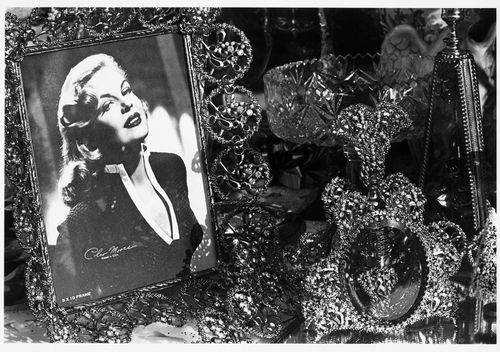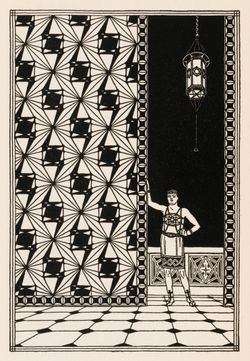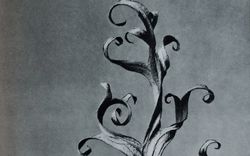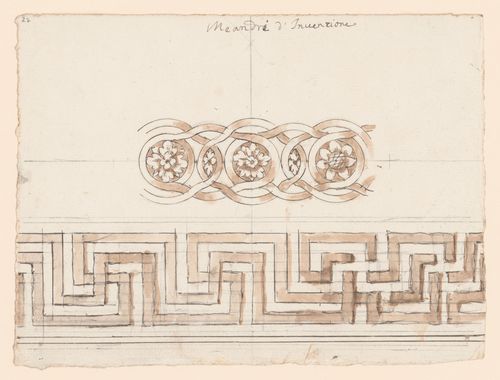PH2000:0099
interior design, portrait
1963
interior design, portrait
Visiting Scholar, Jonathan Massey, Modernism, Ornament, Reform, Crystal and Arabesque, U.S. Modern Architecture, Progressive Era (1893-1918)
15 June 2006
Sub-series
Miscellanea
CI001.S2.D6
Description:
The portfolio 'Oeuvre de C. Rohault de Fleury', published in 1884 (DR1974:0002:029), is introduced by a succinct 'Notice Biographique', the author of which remains unknown. It provides valuable information on his family background and a narrative description of his major works (including unexecuted projects), illustrated by the accompanying unbound prints. The commentary is particulary informative concerning Charles Rohault de Fleury's work at the Muséum national d'histoire naturelle, the 1859 opera house project for the Théâtre Imperiale de l'Opera, and his innovative use of iron (reinforced) floors and roof trusses in both his public and domestic projects. Another copy of this portfolio is located in the CCA library. Album DR1974:0002:026:001-038 (1854-1858) contains drawings of architectural ornament by Charles and/or Georges Rohault de Fleury. Some of the drawing are possibly studies of ornament for Charles' architectural projects of the 1850's such as Hôtel Soltykoff, although others appear to be typical student drawings of classical architecture and ornament executed by Georges. Included are twelve drawings of architectural ornament and sculpture submitted by Georges to a newly introduced 'dessin' Prix d'emulation at the École des beaux-arts (see series CI001.S1: Architetural Education).
[ca. 1825-1884]
Miscellanea
CI001.S2.D6
Description:
The portfolio 'Oeuvre de C. Rohault de Fleury', published in 1884 (DR1974:0002:029), is introduced by a succinct 'Notice Biographique', the author of which remains unknown. It provides valuable information on his family background and a narrative description of his major works (including unexecuted projects), illustrated by the accompanying unbound prints. The commentary is particulary informative concerning Charles Rohault de Fleury's work at the Muséum national d'histoire naturelle, the 1859 opera house project for the Théâtre Imperiale de l'Opera, and his innovative use of iron (reinforced) floors and roof trusses in both his public and domestic projects. Another copy of this portfolio is located in the CCA library. Album DR1974:0002:026:001-038 (1854-1858) contains drawings of architectural ornament by Charles and/or Georges Rohault de Fleury. Some of the drawing are possibly studies of ornament for Charles' architectural projects of the 1850's such as Hôtel Soltykoff, although others appear to be typical student drawings of classical architecture and ornament executed by Georges. Included are twelve drawings of architectural ornament and sculpture submitted by Georges to a newly introduced 'dessin' Prix d'emulation at the École des beaux-arts (see series CI001.S1: Architetural Education).
File 6
[ca. 1825-1884]
drawings
Quantity:
4 File
ARCH29960
Description:
plan of sprinkler system, elevator cars, layout of new kitchen, wrought-iron sign and ornament by A.J. Johnson & Co., Montreal
Plan of sprinkler system, elevator cars, layout of new kitchen, wrought-iron sign
Actions:
ARCH29960
Description:
plan of sprinkler system, elevator cars, layout of new kitchen, wrought-iron sign and ornament by A.J. Johnson & Co., Montreal
drawings
Quantity:
4 File
articles
Direct from Nature
Nature reorganized
Allemagne, Arts and Crafts, Arts et artisanats, Germany, ornament, ornement, photographie, photography, plant, Walter Benjamin
22 January 2010
Nature reorganized
research
Visiting Scholars 2006
Jean Attali, École Nationale Supérieure dArchitecture de Paris-Malaquais, Paris, France Topic: Figures d’énonciation de la pensée architecturale et spatiale: manifestes et oppositions dans les oeuvres d’Aldo Rossi, Peter Eisenman et Rem Koolhaas Cammy Brothers, University of Virginia, Charlottesville, United States Topic: Drawing from Memory: Giuliano da Sangallo and(...)
10 January 2006 to 15 September 2006
Visiting Scholars 2006
Actions:
Description:
Jean Attali, École Nationale Supérieure dArchitecture de Paris-Malaquais, Paris, France Topic: Figures d’énonciation de la pensée architecturale et spatiale: manifestes et oppositions dans les oeuvres d’Aldo Rossi, Peter Eisenman et Rem Koolhaas Cammy Brothers, University of Virginia, Charlottesville, United States Topic: Drawing from Memory: Giuliano da Sangallo and(...)
research
10 January 2006 to
15 September 2006
DR1966:0001:022
Description:
- Two ornament patterns have been sketched on this sheet: the top pattern is a linked chain, in which the links are modified ovals, and the bottom pattern is a fret which appears to be based on a key pattern.
ornament
ca. 1720
Patterns for a Greek fret and scrollwork
Actions:
DR1966:0001:022
Description:
- Two ornament patterns have been sketched on this sheet: the top pattern is a linked chain, in which the links are modified ovals, and the bottom pattern is a fret which appears to be based on a key pattern.
ornament
drawings
DR1981:0017:042 V
Description:
- The alternative designs for ornament in the pediment of this drawing confirm that this is a design development drawing. This design is very close to DR1981:0017:044 V, which shows alternative designs for an altarpiece, possibly for the same site.
architecture
ca. 1630-1640
Elevation of the surround for an altarpiece with a broken pediment and an oculus
Actions:
DR1981:0017:042 V
Description:
- The alternative designs for ornament in the pediment of this drawing confirm that this is a design development drawing. This design is very close to DR1981:0017:044 V, which shows alternative designs for an altarpiece, possibly for the same site.
drawings
ca. 1630-1640
architecture
Sub-series
Miscellanea
CI001.S1.D4
Description:
The three portfolios of "Croquis", originally attributed to Hubert Rohault de Fleury, but probably also including work by Charles, are particularly informative of the range of artistic and architectural interests of these architects. While some of the drawings in these portfolios may be travel sketches or based on travel sketches (Charles is known to have visited some of the locations depicted (1)), the majority are probably copied or adapted from books and prints. In some cases, these sources have been identified. The stylistic range of the drawings is eclectic; in addition to the expected Classical material, Gothic, Romanesque, Islamic, Exotic Revival (namely Etruscan and Egyptian), Renaissance and Baroque periods and styles as well as contemporary 19th century architecture are all represented. The subject matter is equally varied. DR1974:0002:032:001-066, two portfolios, includes arabesque ornament (some from Palazzo del Te and Palazzo Ducal in Mantua (2)), Islamic ornament motifs, tile patterns, Sicilian architectural subjects - mainly church interiors, and stonework and woodwork from Romanesque and Gothic structures . DR1974:0002:031:001-055, three portfolios, contains drawings of classical figures, Christian imagery and architectural sculpture from antique, medieval [?] and 19th century sources, sculpture from the 16th century sepulchral monument of Maximillian I, Italian Classical structures and contemporary classically-inspired subject matter including a number of Parisian fountains and monuments, and several English townhouses. DR1974:0002:030:001-065, four portfolios, includes drawings of Classical, Gothic and Exotic Revival buildings and interiors as well as a number of drawings of non-architectural subject matter including military subjects - fortification, armaments, soldiers, and revolutionary battle scenes - and topographic views. A folder of Italian views and buildings in this portfolio may have been intended for publication. The designs for interiors, Empire furniture, garden structures and several of the buildings are probably original designs by Hubert. (1) A description of Charles' travels based on his sketchbooks held by the Académie d'architecture is found in Académie d'architecture, 'Catalogue des collection' (Paris: Académie d'architecture, 1988) 35-36 and 230-241. (2) These drawings were copied from Wilhelm Zahn, 'Gemalte Ornamente von Julio Romano' (s.l., s.n, ca. 1833)., The three portfolios of "Croquis" were originally attributed to Hubert Rohault de Fleury, but probably also including work by Charles. The source and purpose of many of these drawings is unclear; some may be record drawings and travel sketches or based on travel sketches, but the majority are probably copied or adapted from books and prints. The stylistic range and subject matter of the drawings is broad and eclectic: arabesques, Islamic ornament, stonework and woodwork from Romanesque and Gothic structures (DR1974:0002:032:001-066); classical and Christian imagery, architectural sculpture from antique, medieval [?] and 19th century sources, Italian Classical structures, nineteenth century classically-inspired subject matter (DR1974:0002:031:001-055); non-architectural subject matter including military subjects, topographic views, and Italian views and buildings, possibly intended for publication (DR1974:0002:030:001-065). Portfolio, DR1974:0002:030:001-065 also includes interiors, Empire furniture, garden structures and Classical, Gothic and Exotic Revival buildings, some of which are probably original designs by Hubert Rohault de Fleury. Bibliography: - Bergdoll, Barry. "Hubert Rohault de Fleury: Cinquième Partie: Équisses et Dessins d'Ornament." 'CCA Research Report.' n.d. - Académie d'architecture (France). 'Catalogue des collections' (Paris: L'Academie, 1988), 35-37 and 230-241.
[1800-1868]
Miscellanea
CI001.S1.D4
Description:
The three portfolios of "Croquis", originally attributed to Hubert Rohault de Fleury, but probably also including work by Charles, are particularly informative of the range of artistic and architectural interests of these architects. While some of the drawings in these portfolios may be travel sketches or based on travel sketches (Charles is known to have visited some of the locations depicted (1)), the majority are probably copied or adapted from books and prints. In some cases, these sources have been identified. The stylistic range of the drawings is eclectic; in addition to the expected Classical material, Gothic, Romanesque, Islamic, Exotic Revival (namely Etruscan and Egyptian), Renaissance and Baroque periods and styles as well as contemporary 19th century architecture are all represented. The subject matter is equally varied. DR1974:0002:032:001-066, two portfolios, includes arabesque ornament (some from Palazzo del Te and Palazzo Ducal in Mantua (2)), Islamic ornament motifs, tile patterns, Sicilian architectural subjects - mainly church interiors, and stonework and woodwork from Romanesque and Gothic structures . DR1974:0002:031:001-055, three portfolios, contains drawings of classical figures, Christian imagery and architectural sculpture from antique, medieval [?] and 19th century sources, sculpture from the 16th century sepulchral monument of Maximillian I, Italian Classical structures and contemporary classically-inspired subject matter including a number of Parisian fountains and monuments, and several English townhouses. DR1974:0002:030:001-065, four portfolios, includes drawings of Classical, Gothic and Exotic Revival buildings and interiors as well as a number of drawings of non-architectural subject matter including military subjects - fortification, armaments, soldiers, and revolutionary battle scenes - and topographic views. A folder of Italian views and buildings in this portfolio may have been intended for publication. The designs for interiors, Empire furniture, garden structures and several of the buildings are probably original designs by Hubert. (1) A description of Charles' travels based on his sketchbooks held by the Académie d'architecture is found in Académie d'architecture, 'Catalogue des collection' (Paris: Académie d'architecture, 1988) 35-36 and 230-241. (2) These drawings were copied from Wilhelm Zahn, 'Gemalte Ornamente von Julio Romano' (s.l., s.n, ca. 1833)., The three portfolios of "Croquis" were originally attributed to Hubert Rohault de Fleury, but probably also including work by Charles. The source and purpose of many of these drawings is unclear; some may be record drawings and travel sketches or based on travel sketches, but the majority are probably copied or adapted from books and prints. The stylistic range and subject matter of the drawings is broad and eclectic: arabesques, Islamic ornament, stonework and woodwork from Romanesque and Gothic structures (DR1974:0002:032:001-066); classical and Christian imagery, architectural sculpture from antique, medieval [?] and 19th century sources, Italian Classical structures, nineteenth century classically-inspired subject matter (DR1974:0002:031:001-055); non-architectural subject matter including military subjects, topographic views, and Italian views and buildings, possibly intended for publication (DR1974:0002:030:001-065). Portfolio, DR1974:0002:030:001-065 also includes interiors, Empire furniture, garden structures and Classical, Gothic and Exotic Revival buildings, some of which are probably original designs by Hubert Rohault de Fleury. Bibliography: - Bergdoll, Barry. "Hubert Rohault de Fleury: Cinquième Partie: Équisses et Dessins d'Ornament." 'CCA Research Report.' n.d. - Académie d'architecture (France). 'Catalogue des collections' (Paris: L'Academie, 1988), 35-37 and 230-241.
File 4
[1800-1868]
Project
CI005.S1.1917.PR3
Description:
The Seafront Terrace Housing, or "Strandboulevard" was originally designed by Oud for the property developer, Maatschappij Oostduinen Scheveningen. Oud was originally commissioned to build only for one strip of development. He designed nine three-storey luxury units that could be repeated any number of times. Oud's contemporaries viewed the design as embodying the Dutch artistic movement, De Stijl. The sea-front elevation for the design is cubic. While Oud eventually opted for an unornamented design, his original drawings featured masonry ornaments and panelling (Taverne et al. 2001, 145-148). Project series includes drawings of plans, photographs of drawings, and a photograph of a model.
1916
Seafront Terrace Housing (Strandboulevard), The Hague, Netherlands (1916)
Actions:
CI005.S1.1917.PR3
Description:
The Seafront Terrace Housing, or "Strandboulevard" was originally designed by Oud for the property developer, Maatschappij Oostduinen Scheveningen. Oud was originally commissioned to build only for one strip of development. He designed nine three-storey luxury units that could be repeated any number of times. Oud's contemporaries viewed the design as embodying the Dutch artistic movement, De Stijl. The sea-front elevation for the design is cubic. While Oud eventually opted for an unornamented design, his original drawings featured masonry ornaments and panelling (Taverne et al. 2001, 145-148). Project series includes drawings of plans, photographs of drawings, and a photograph of a model.
project
1916



